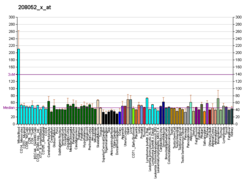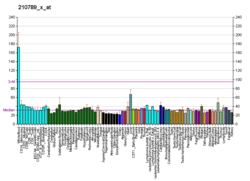CEACAM3
| CEACAM3 | |||||||
|---|---|---|---|---|---|---|---|
| Identifiers | |||||||
| Aliases | CEACAM3, CD66D, CEA, CGM1, W264, W282, carcinoembryonic antigen related cell adhesion molecule 3 | ||||||
| External IDs | HomoloGene: 130497 GeneCards: CEACAM3 | ||||||
| RNA expression pattern | |||||||
 
|
|||||||
| More reference expression data | |||||||
| Orthologs | |||||||
| Species | Human | Mouse | |||||
| Entrez |
|
|
|||||
| Ensembl |
|
|
|||||
| UniProt |
|
|
|||||
| RefSeq (mRNA) |
|
|
|||||
| RefSeq (protein) |
|
|
|||||
| Location (UCSC) | Chr 19: 41.8 – 41.81 Mb | n/a | |||||
| PubMed search | n/a | ||||||
|
|
|||||||
n/a
n/a
n/a
n/a
n/a
Carcinoembryonic antigen-related cell adhesion molecule 3 (CEACAM3) also known as CD66d (Cluster of Differentiation 66d), is a human gene.
This gene encodes a member of the family of carcinoembryonic antigen-related cell adhesion molecules (CEACAMs), which are used by several bacterial pathogens to bind and invade host cells. The encoded transmembrane protein directs phagocytosis of several bacterial species that is dependent on the small GTPase Rac. It is thought to serve an important role in controlling human-specific pathogens by the innate immune system. Alternatively spliced transcript variants have been described, but their biological validity has not been determined.
CEACAM3 is expressed exclusively on granulocytes and used as granulocyte marker.
This article incorporates text from the United States National Library of Medicine, which is in the public domain.
...
Wikipedia
